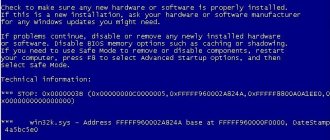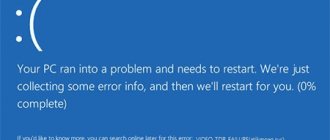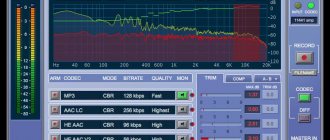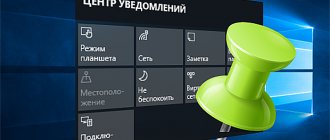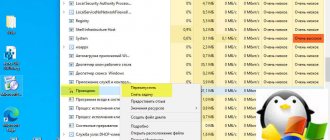Reasons for the ntdll.dll library error
An error associated with a malfunction of this library can manifest itself in two ways. As a rule, most often a message simply appears about the abnormal termination of a particular application (even standard Windows Explorer).
If you click on the “Show problem details” button, the faulty ntdll.dll file will be indicated in the description.
In the second case, the error may appear as a line on a blue screen, which simply scares many users because they think that this is the so-called “screen of death”. This is not entirely true. However, now it doesn’t matter.
The main reason for such failures can be called the installation of outdated software (most often games), which either changes the ntdll.dll file or simply replaces it. What else can be done to fix the problem?
How to fix the "Ntdll.dll is missing (not found)" error
Sometimes ntdll.dll and other DLL system errors can be related to problems in the Windows registry. Several programs can use the ntdll.dll file, but when those programs are uninstalled or modified, sometimes "orphaned" (invalid) DLL registry entries are left behind.Basically, this means that while the actual path of the file may have changed, its incorrect former location is still recorded in the Windows Registry. When Windows tries to look up these incorrect file references (file locations on your PC), ntdll.dll errors can occur. Additionally, a malware infection may have corrupted Windows-related registry entries. Thus, these corrupted DLL registry entries need to be fixed to fix the problem at the root.
Manually editing the Windows registry to remove invalid ntdll.dll keys is not recommended unless you are PC service professional. Mistakes made when editing the registry can render your PC inoperable and cause irreparable damage to your operating system. In fact, even one comma placed in the wrong place can prevent your computer from booting!
Due to this risk, to simplify the process, it is recommended to use a program to clean the OS registry. A registry cleaner automates the process of finding invalid registry entries, missing file references (like the one causing your ntdll.dll error), and broken links in the registry. Before each scan, a backup is automatically created with the ability to undo any changes with one click, protecting against the possibility of damaging your PC.
As a Microsoft Silver Partner, we provide software to help you resolve the following issues:
- WinThruster OS registry cleaner [download]
Warning: Unless you are an experienced PC user, we DO NOT recommend manually editing the Windows Registry. Using Registry Editor incorrectly may cause serious problems that may require you to reinstall Windows. We do not guarantee that problems resulting from incorrect use of Registry Editor can be corrected. You use Registry Editor at your own risk.
Before you manually repair your Windows registry, you need to create a backup by exporting a portion of the registry associated with ntdll.dll (eg. Windows):
- Click on the Start .
- Type " command " in the search bar... DON'T PRESS ENTER YET !
- CTRL-Shift keys on your keyboard, press ENTER .
- A dialog box for access will be displayed.
- Click Yes .
- The black box opens with a blinking cursor.
- Type " regedit " and press ENTER .
- In the Registry Editor, select the ntdll.dll-related key (eg. Windows) you want to back up.
- From the File , select Export .
- In the Save in , select the folder where you want to save the Windows key backup.
- In the File name , enter a name for the backup file, for example, “Windows backup.”
- Make sure that the Export Range is set Selected Branch .
- Click Save .
- The file will be saved with the extension .reg .
- You now have a backup of your ntdll.dll-related registry entry.
The following steps for manually editing the registry will not be described in this article, as they are likely to damage your system. If you would like more information about editing the registry manually, please check out the links below.
We do not accept any responsibility for the results of the actions performed according to the instructions below - you perform these tasks at your own risk.
Windows XP https://www.theeldergeek.com/windows_xp_registry.htm
Windows 7 https://www.theeldergeek.com/windows_7/registry_edits_for_win7.htm
Windows Vista https://support.microsoft.com/kb/2688326 - LetMeFixItMyselfAlways
System Restore
Access to recovery options is made through the “Control Panel” using the “Backup and Restore” section.
Here you will need to display all the points, having first remembered when this problem appeared. Upon completion of the process, the system will restore the desired file and also remove the program that affected its performance.
ntdll dll error windows 7
This error appears in Windows 7, 8 when starting the application.
It is initiated, usually in the form of an AppCrash window, with information about the application that crashed and the ntdll.dll module
Most often, applications that come under attack are outdated versions that were not designed for 64-bit operating systems.
ntdll.dll is a universal module that contains many functions of Windows operating systems starting with Windows Vista. Most of the Windows XP system functions are implemented in this module. Probably for this reason, older versions of programs may not always work correctly in Win7, 8.
Loading the original file
However, there is a simpler option. So, for example, for each build of the original Windows OS today on the Internet you can find many links to download the original ntdll.dll library, taken from a “clean” system immediately after installation.
Everything is simple here. First you need to download the file to your computer and then integrate it into the system (System32 folder in the Windows root directory).
What is ntdll.dll?
As you may have guessed judging by the extension, ntdll is a type of DLL file. This acronym stands for "dynamic link library". If we talk specifically about ntdll.dll, they are a kind of “mini-programs” that have common features with EXE format files.
To describe their purpose briefly, thanks to this library, many programs successfully use functions that are present in a number of applications. For example, a user wants to print a Word document. In Microsoft's text editor, when you click the "Print" button, Word calls the DLL that is installed on the printer. There may be times when you need to print a document in Adobe Acrobat. In this case, for printing you will need the same “printer” DLL file.
In general, since the library files are shared and act for several applications at once, they are located in a separate place.
Of course, for many developers, such elements are a real godsend, but it’s the very third-party position of the library outside of applications that initiates problems.
Using compatibility mode when running programs
In some cases, the problem may appear specifically on Windows 7, 8 and 10 systems when running applications designed exclusively for Windows XP.
Here you need to use the compatibility settings when running the program executable file (.exe), which is accessed through the right-click properties menu. It is enough to select the desired version or build of Windows OS in the mode field, even indicating the installed service packs, and also enable the option to run the program as an administrator.
Possible solutions
- Launching the problematic application with predetermined parameters.
In the file properties, specify that it must be run as an administrator and in compatibility mode for Windows Xp. These steps will allow Windows to use the problematic components in the appropriate mode. The compatibility tab of the exe file properties allows you to set parameters for launching the program in compatibility mode with previous versions of Windows, and also specify that the launch should be performed as a system administrator - Disable User Account Control in Windows Settings. It is possible that the user security policy on the computer does not allow a certain user to access the dll. This step allows any user registered on the computer to gain access to the ntdll libraries and other components necessary for operation.
- If the previous steps did not help in fixing the ntdll error, you can try disabling the Compatibility Assistant. This will allow you to configure Windows 7 compatibility yourself.
What to do if the problem with ntdll.dll is not resolved after completing the above steps.
If after all the steps to set up compatibility the error is not resolved, then you will have to use more complex methods.
- Selection of suitable libraries and drivers for the application. In this situation, it is necessary to determine the program causing the crash. After this, we either remove this program from the computer to avoid further complications in Windows 7, or we try to find information about the corresponding file or dll on the developer’s website. If the developer updates the program, he will provide an update that will solve the problem.
- Gradual removal of applications. The ntdll.dl error can occur even when starting the standard File Explorer file manager.
This occurs when standard Windows 7 components and services access the problematic file. It is almost impossible to determine the installed program that causes the error. Therefore, we gradually remove programs in their installation queue. After each removal, reboot the computer. If the error disappears when loading Windows 7, then the problem is solved. If everything remains as before, then the incorrect module or dll remains in the system and you need to continue removal.
Other methods
Sometimes, if the above methods do not help, you can try disabling the Application Compatibility Assistant service or User Account Control service. In most cases this is not required.
However, this problem can be observed on processors such as Intel Core i3-i5, and according to many experts and users, the situation cannot be corrected at all. Well, there's nothing you can do about it - you'll have to reinstall the entire system.
Of course, you can try to use a software product such as DLL Suite or DLL-Files Fixer, but the only thing that can be achieved is the usual download of a dynamic library to your computer (though immediately with integration in the right place).
Finally, it remains to add that system recovery is, in the opinion of many, the most preferable method. If you need to use software for XP, it is better to enable compatibility mode or simply find a version designed to work on newer operating systems (even 32-bit for systems with 64-bit architecture).
What is this Appcrash problem when launching games?
As mentioned above, when you try to launch any program (usually games), the “Problem event name Appcrash application name” window appears on the screen, indicating that the program you are launching has stopped working. This window also suggests closing or restarting the proposed program, contains a mention of APPCRASH (application crash), an error number and a link to the module that caused the described dysfunction. The dynamic libraries ntdll.dll, kernelbase.dll, essent.dll, xlive.dll and others are most often mentioned as such a module.
Problem starting Skype
It is clear that this problem with Appcrash occurs most often when running modern games with high quality graphics and a corresponding load on the system - Assasin's Creed, Dota 2, GTA 5, Fifa, Steam applications and a number of others. After this error, in most cases, an error occurs when starting the application 0xc0000142, and when installing DirectX, the error dxerror.log and directx.log occurs.
Incompatibility of the program with the system is the first sign of an error.
So, now let's move directly to the instructions that will help solve this problem.
It is worth noting that one of the most common reasons for the appearance of ntdll.dll is the incompatibility of the program with the current version of the OS.
Actually, this is quite logical, since outdated software initiates various failures in the system, in particular in the operation of applications. To set compatibility mode, right-click on the program shortcut and find the “Properties” item in the menu (usually located at the end of the list). Then go to the third tab called Compatibility. In the contents tab, find the line “Compatibility Mode” and check the box located under the line. Even lower, you will see a drop-down menu where you will need to select “Windows XP (Service Pack 3)”. At the bottom of the screen o. To activate the new settings, click on the OK button.
This method will allow the system to use problematic components in the right direction, which will lead to the elimination of the error.
